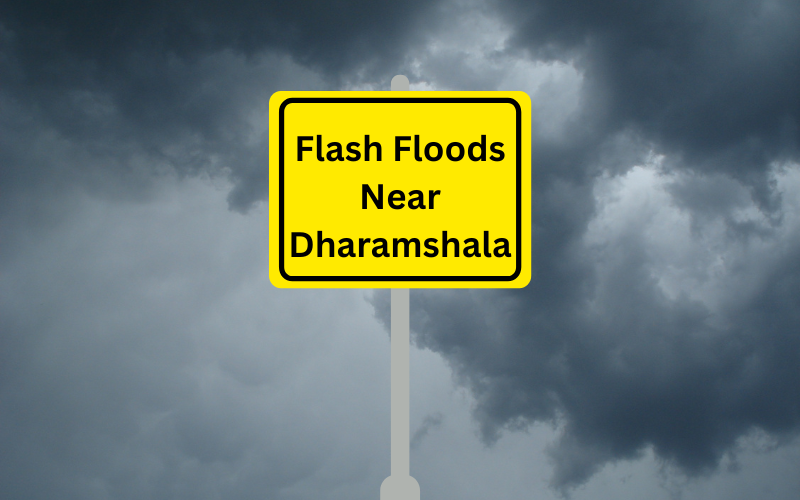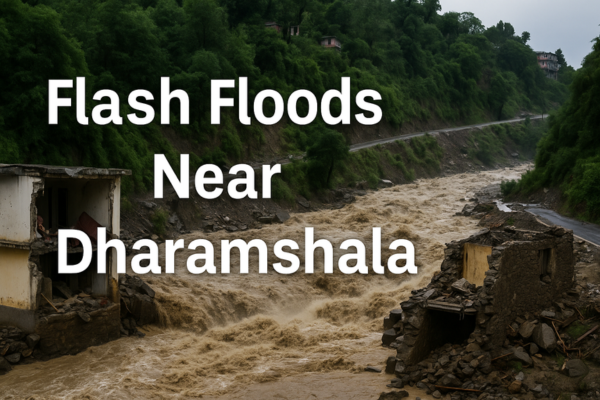
Flash Floods Ravage Dharamshala: Tragedy Strikes Amid Sudden Deluge
The tranquil landscapes of Dharamshala, a region revered for its serene beauty and vibrant culture, have been marred by a catastrophic natural disaster. Flash floods near Dharamshala have claimed two lives and left six individuals unaccounted for, sparking an intense rescue operation amidst challenging conditions. This unforeseen calamity has thrust the region into chaos, highlighting the urgent need for environmental awareness and disaster preparedness.
Torrential Rains Trigger Flash Floods
In what has been described as one of the most severe weather events in recent memory, torrential rains lashed the Dharamshala region, triggering flash floods. The sudden influx of water overwhelmed rivers and streams, causing them to spill over their banks with devastating consequences. Witnesses reported walls of water cascading through villages, sweeping away homes, vehicles, and infrastructure.
The flash floods near Dharamshala have left residents in shock and grief. “It was as if the heavens opened up,” said one local, recounting the harrowing moments when the floodwaters engulfed their community. Emergency services were immediately mobilized, but the scale of the disaster has posed significant challenges to relief efforts.
Adding to the woes, the incessant rainfall has caused landslides, further complicating rescue operations and making roadways impassable. Experts suggest that the region’s vulnerability to such disasters has been exacerbated by unregulated construction along riverbanks, which has disrupted natural water flow and weakened the area’s resilience against extreme weather events. These flash floods near Dharamshala have prompted calls for immediate action.
Human Toll and Ongoing Rescue Efforts
As rescue operations continue, authorities have confirmed that two people have lost their lives, while six remain missing. The flash floods near Dharamshala have turned once-peaceful neighborhoods into scenes of devastation, with search-and-rescue teams working tirelessly to locate survivors.
Helicopters and specialized disaster response teams have been deployed to comb through the affected areas. However, persistent rainfall and treacherous terrain have hampered efforts. Despite these obstacles, the community’s resilience shines through as volunteers join forces with officials to provide aid and comfort to those in need.
Temporary shelters have been established to house the displaced, offering food, medical care, and psychological support. These shelters have become a sanctuary for families who have lost everything to the floodwaters, embodying hope amidst despair. Among the displaced are elderly residents and children, who require additional care and attention to cope with the trauma of the disaster. The flash floods near Dharamshala have tested the strength and unity of the community.
The government’s priority remains on locating the missing and ensuring the safety of those in vulnerable areas. The National Disaster Response Force (NDRF) has intensified its efforts, deploying advanced equipment and search dogs to navigate the debris. Local authorities have also urged residents in flood-prone zones to evacuate immediately, emphasizing the importance of prioritizing safety over possessions.
Environmental Factors at Play
The flash floods near Dharamshala have once again underscored the vulnerabilities of the region’s ecosystem. Experts have pointed to a combination of deforestation, unplanned urbanization, and climate change as factors exacerbating the severity of such natural disasters. Dharamshala’s fragile environment is struggling to cope with the pressures of human activity and the unpredictability of extreme weather events.
Environmentalists have called for immediate action to address these challenges. “The frequency and intensity of such disasters are a wake-up call,” said one expert. Implementing sustainable practices and enforcing stricter regulations on construction and land use are seen as critical steps to mitigate future risks.
Moreover, the role of illegal sand mining in aggravating the situation cannot be overlooked. Excessive extraction of sand from riverbeds has reduced the natural capacity of rivers to contain floodwaters, leading to frequent overflows. Activists have long warned about the dire consequences of ignoring these environmental concerns.
The flash floods near Dharamshala also point to the need for better urban planning. Uncontrolled urban sprawl and construction on vulnerable terrains have significantly reduced the land’s ability to absorb water, intensifying the impact of heavy rainfall. Experts recommend creating green buffers and regulating construction in flood-prone areas to minimize future damage. Flash floods near Dharamshala have become a recurring issue due to these environmental factors.
Additionally, agricultural practices in the region have contributed to soil erosion, reducing the land’s capacity to withstand heavy rainfall. Adopting sustainable farming techniques, such as terracing and cover cropping, could play a crucial role in preventing similar disasters in the future. The flash floods near Dharamshala highlight the urgent need for these changes.
Stories of Courage and Loss
Amid the chaos, stories of courage and resilience continue to emerge from the affected communities. Residents have shared harrowing accounts of their experiences during the flash floods near Dharamshala. One survivor described clinging to a tree for hours as the waters surged around them, while another recounted how they managed to save their family by seeking refuge on the roof of their home.
For many, the loss has been profound. Families mourn loved ones who were swept away by the relentless floodwaters. These personal stories highlight the human cost of the disaster and the indomitable spirit of those who continue to fight for survival.
In the midst of despair, there have also been remarkable acts of bravery. A local youth group rescued over a dozen stranded villagers using makeshift rafts. Their quick thinking and selflessness have been lauded as an inspiring example of community solidarity. Additionally, several residents have opened their homes to shelter those displaced by the disaster, exemplifying humanity’s capacity for compassion. Flash floods near Dharamshala have brought out both the best and worst of times for its residents.
Among the most heart-wrenching stories is that of a mother who shielded her child from the floodwaters, sacrificing her own life. Such acts of love and sacrifice underscore the profound human toll of the flash floods near Dharamshala. These stories serve as a reminder of the resilience of the human spirit in the face of immense adversity.
Local businesses have also stepped up, providing free meals and essential supplies to those affected. The collective efforts of ordinary citizens have demonstrated the strength of community bonds in times of crisis, offering a glimmer of hope amid the devastation.
Government Response and Relief Measures
The government has been swift in its response, announcing financial assistance for the families of the deceased and the displaced. Relief packages, including food supplies, blankets, and medical kits, are being distributed across the affected areas. Efforts are also underway to restore connectivity and rebuild damaged infrastructure.
Officials have pledged to investigate the causes of the flash floods near Dharamshala and implement measures to prevent similar incidents in the future. While these initiatives are commendable, many believe that long-term planning and proactive strategies are essential to addressing the root causes of such tragedies.
The Chief Minister of Himachal Pradesh has called for a comprehensive review of the state’s disaster management protocols. “We must ensure that we are better prepared for such calamities in the future,” he stated during a press briefing. Plans to strengthen early warning systems and improve evacuation procedures are currently being discussed.
Meanwhile, international aid agencies have offered their support, providing additional resources and expertise to aid in recovery efforts. The flash floods near Dharamshala have drawn attention to the importance of global solidarity in responding to natural disasters. Collaborative efforts between local and international organizations are expected to expedite relief and rehabilitation. The flash floods near Dharamshala have become a symbol of the need for better coordination in disaster management.
In addition to immediate relief efforts, the government has announced plans to conduct a detailed environmental impact assessment of the region. This study aims to identify vulnerable areas and recommend measures to strengthen the region’s resilience to future disasters. A significant portion of the budget has been allocated to rebuilding critical infrastructure and improving disaster preparedness programs.
The Role of Climate Change
Climate change has been identified as a significant contributor to the increasing frequency and intensity of natural disasters. The flash floods near Dharamshala serve as a stark reminder of the need to address global warming and its impacts on vulnerable regions. Rising temperatures and shifting weather patterns have led to more extreme rainfall events, placing communities like Dharamshala at greater risk.
Experts emphasize the importance of integrating climate resilience into development planning. Strengthening infrastructure, preserving natural habitats, and adopting renewable energy sources are among the measures that can help mitigate the effects of climate change.
Additionally, the international community must take collective action to combat climate change. Initiatives such as reforestation, reducing carbon emissions, and investing in green technologies are crucial to safeguarding the planet and its inhabitants from future disasters. Collaborative efforts between nations can amplify the impact of these measures, creating a more sustainable future.
The flash floods near Dharamshala also highlight the importance of education and awareness. Communities must be equipped with the knowledge and resources to adapt to changing climatic conditions. Building local capacity to respond to disasters is essential for minimizing the impact of future events. The lessons from the flash floods near Dharamshala should guide future policy decisions.
Educational institutions in the region have begun incorporating climate awareness programs into their curricula. By fostering a culture of environmental stewardship among the youth, these initiatives aim to create a generation better prepared to tackle the challenges posed by climate change.
Rebuilding Lives and Communities
As the waters recede, the focus shifts to rebuilding lives and communities. The flash floods near Dharamshala have left a trail of destruction, but they have also revealed the strength and solidarity of the affected population. From local volunteers to national agencies, efforts are being made to provide the resources and support needed for recovery.
Reconstruction efforts will include repairing homes, schools, and roads, as well as restoring essential services such as electricity and water supply. These initiatives aim to bring a sense of normalcy back to the lives of those affected by the disaster.
Community organizations have also stepped up, launching crowdfunding campaigns to support recovery efforts. These initiatives have garnered widespread support, with donations pouring in from across the country and abroad. The funds raised will be used to rebuild critical infrastructure and provide long-term assistance to the affected families. The flash floods near Dharamshala have also inspired innovation in disaster recovery approaches.
Innovative solutions are being explored to rebuild in a more resilient manner. Engineers are considering flood-resistant designs for homes and public buildings, while urban planners advocate for the creation of flood zones and natural drainage systems. The flash floods near Dharamshala have spurred a collective resolve to rebuild stronger and smarter.
Local artisans have also joined the rebuilding efforts, creating memorials to honor those lost in the disaster. These symbolic gestures serve as reminders of the importance of resilience and the enduring strength of the human spirit.
A Call to Action
The tragedy of the flash floods near Dharamshala is a sobering reminder of the interconnectedness of human activities and natural phenomena. It calls for collective action at all levels—local, national, and global—to protect our planet and its inhabitants from the devastating impacts of climate change.
As Dharamshala embarks on the path to recovery, the lessons learned from this disaster must serve as a guide for building a more resilient and sustainable future. The focus keyword, “Flash Floods Near Dharamshala,” not only highlights the immediate crisis but also underscores the need for a proactive approach to safeguarding our environment and communities.
Beyond recovery, there lies an opportunity to transform tragedy into a catalyst for change. The time to act is now—to honor the lives lost, support the survivors, and ensure that such disasters become less frequent and less devastating in the years to come. The flash floods near Dharamshala will remain a testament to the challenges of our time and the enduring hope for a safer future.

